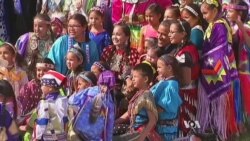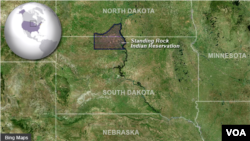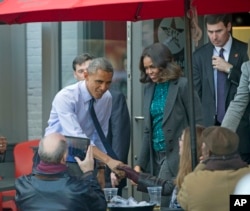Nearly 100 kilometers from the nearest city - amid rolling hills of grazing cattle - Cannon Ball, North Dakota, with a population of less than a 1,000 people, is an unlikely place for a presidential visit.
Randi Dogskin remembers the June day when President Barack Obama and first lady Michelle Obama came to Standing Rock Indian Reservation with a pledge to improve the lives of Native Americans.
“I grew up here in Cannon Ball and my family is from here and that was just an amazing thing,” said Dogskin.
On this cold November day, Dogskin is helping a group of young kids and their parents make snow globes during family night at Cannon Ball Grade School.
As more than 500 tribal leaders gather in Washington on Wednesday for the annual White House Tribal Nations Conference, the mother of two, who works in suicide prevention, has a message for the Obama administration.
“We just need a lot more funding for programs, so we can come out and do a lot of activities for the youth, especially because they are going to be our leaders one day and we want them to have to that opportunity,” said Dogskin.
Presidential Priorities
Barack Obama became only the fourth sitting U.S. president to visit a Native American reservation - when he traveled to Standing Rock, which stretches across more than 800,000 hectares (two million acres) of North and South Dakota on June 5 of this year. Some 40 percent of residents here live below the poverty level, and the unemployment rate is near 80 percent.
In his speech at Standing Rock, Obama touted his administration’s investments in job training, tribal colleges and infrastructure, as well as a commitment to improving the tribal justice system. The issues will also be a focus when administration officials meet with tribal leaders on December 3.
Above all, he pledged to strengthen tribal communities through economic development and education.
“Let’s put our minds together to improve our schools - because our children deserve a world-class education, too, that prepares them for college and careers," Obama said. "And that means returning control of Indian education to tribal nations with additional resources and support so that you can direct your children’s education and reform schools here in Indian country.”
The president and the first lady met with tribal leaders and spoke to a group of young people at Cannon Ball Grade School about some of the challenges they face.
For school board member Sue Isbell, some of those challenges are more apparent. As she walks through the school that was built in the 1930s, Isbell points to mold, leaky ceilings and cramped, cold classrooms as stumbling blocks for Native American students, who already struggle with among the highest high school drop out rates in the nation.
“We need more funding for a new school. These kids have already been through so much," she said. "With a better facility, we can recruit more teachers, and give students a fighting chance.”
Tribal Colleges Bridging Unemployment Gap
As one of the first master's degree students in environmental science at Sitting Bull College, Louis Walking Elk eventually wants to use his degree to help those on the reservation. The 24-year-old is one of the first in his family to go to college.
“My dad and mom both encouraged me all throughout my life, my dad especially. He didn’t finish high school and he was always like, 'you have to do something,'” he said.
Situated on Standing Rock Indian Reservation, Sitting Bull College in Fort Yates, North Dakota, is one of more than 30 tribal colleges in the United States.
Some 300 students, including student body president Dakota Kidder, are completing their higher education at this federally-funded school in hopes of defying statistics that show only about 10 percent of Native Americans have a college degree, roughly half the national average.
“We do have a lot of problems on the reservation. And Sitting Bull College does all that it can to make sure students are getting to class, whether it be transportation, child care,” said Kidder.
The mission of getting more Native Americans to college and making sure they leave with a degree is crucial to the school's president, Laurel Vermillion.
“A huge majority are first generation students, college students, who don’t have a lot of experience," she said. "They don’t have parents who can tell them or talk about college. And so when they leave the reservation and go onto these big, mainstream campuses, they are lost.”
Vermillion said many young Native Americans, particularly men, are looking for that sense of direction and purpose. The school has begun offering classes in welding and oil drilling, in hopes of boosting the 30:70 male to female student ratio.
Scott Davis, the executive director of the North Dakota Indian Affairs Commission, is also working to close the unemployment gap, helping tribal colleges get millions of dollars to start such workforce development programs.
“There are plenty of jobs. We are talking right now [in] North Dakota, anywhere from 22,000 to 25,000 jobs right now, and they are not a lot of people to fill them in small, rural North Dakota," he said. "But on the flip side of that coin, you have still some of our tribes really struggling with the unemployment rate.”
Fighting to Keep Language Alive
In addition to his pledge for increased employment and educational opportunities, Obama has also made Native American cultural preservation a priority for his administration. During his visit to Standing Rock, he praised tribal leaders’ efforts to revitalize their endangered tongue.
The efforts are showcased at one evening a week in Michael Moore’s classroom at Sitting Bull College. Young and old gather here to learn Lakota - a language their Sioux great grandparents spoke fluently at home.
But that changed in the early 1900s, when thousands of Native American children were sent to boarding schools where they were told to assimilate, learn English and forget all aspects of their native culture.
Gabe Black Moon, who co-teaches Lakota with Moore, remembered his time at one such school.
“The government punished [us for speaking] our language, and I've seen that happen. It happened to me," he said. "Day one, I went to school, I couldn’t speak English. I got punished pretty bad.”
One of the few Sioux Indians left who speaks fluent Lakota, Black Moon said he now devotes his days to making sure the language doesn't die out with his generation.
He said he is heartened to see younger generations learning to communicate in precisely the manner from which their parents were discouraged from speaking.
One such student, Tiffany Baker, said she decided to learn Lakota to talk with her two-year-old daughter, who is in an immersion program at the college.
She said her own father rarely spoke Lakota.
“As the elders start passing away, they are taking all their knowledge that they have," she said, describing that class as vital to reclaiming a part of their culture that was nearly lost. "It’s up to us to learn it so that we can carry it on.”










